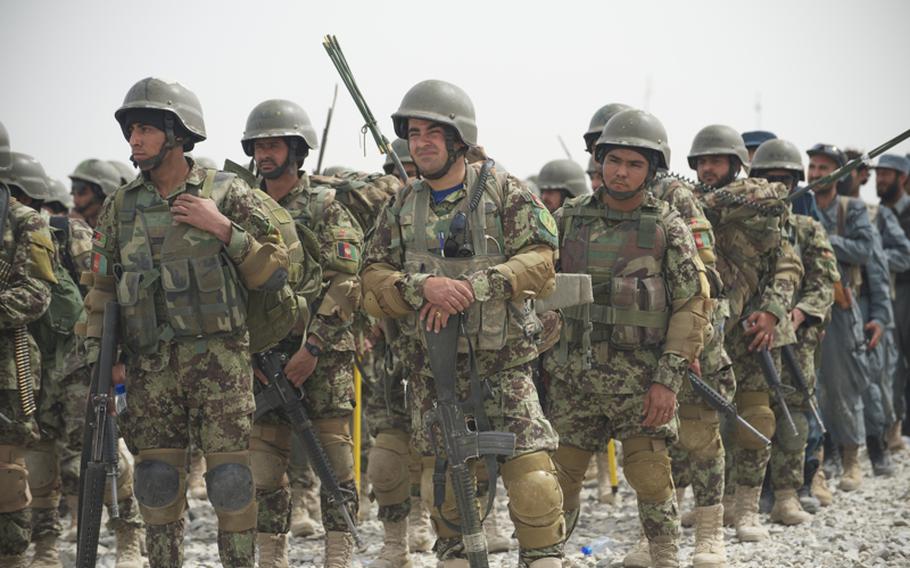
Soldiers from the 1st Brigade, 205th Afghan National Army Corps prepare for training in Kandahar province, Afghanistan, in March 2012. (Defense Department)
KABUL — Halfway through the first summer that Afghan forces have been in the lead for combat operations, the commander of coalition ground forces says he is cautiously optimistic about their performance, despite a skyrocketing casualty rate.
In a wide-ranging interview, Lt. Gen. Mark Milley, the No. 2 commander for the NATO-led International Security Assistance Force (ISAF), said this summer — ahead of both a presidential election and the withdrawal of all international combat troops next year — will prove pivotal to the outcome of the nearly 12-year-old war in Afghanistan. Summer is the traditional fighting season, as insurgents stream back into the country from their winter redoubts in Pakistan.
“This is the first big operational and strategic test” for the Afghan forces, he said.
As head of ISAF’s joint command, Milley is involved in day-to-day planning and strategy for combat operations across the country.
He said it’s too early to draw concrete conclusions about the performance of the Afghan security forces, but sounded a positive note, saying that of the 1,000-2,000 combat patrols executed by Afghans each day, only 10 to 20 percent are conducted with international advisers present.
“It’s not by any means conclusive, but it’s promising,” he said in a joint interview with Stars and Stripes and the German news agency, DPA.
Milley focused on the Afghan security force’s success in the most populated areas of the country, repeating the oft-cited ISAF statistic that the majority of insurgent violence is taking place in rural areas with only about 20 percent of the Afghan population.
“They recognize they are fighting an insurgency and recognize that [winning over] the population is fundamental to a counterinsurgency,” he said.
There is some trepidation in the Afghan ranks, though, about the ability of the forces to hold rural areas where ISAF is quickly leaving bases, often bulldozing them rather than turning them over to Afghans, who are not always able to maintain the outposts.
“I cannot cover every inch of the country. The Afghan army isn’t big enough,” Gen. Sher Mohammad Karimi, the army’s chief of staff, told The Washington Post in an article that appeared Thursday.
The Afghans are also paying a heavy price for their increasing independence: as Afghan troops have taken the lead in combat operations, their casualty rate has skyrocketed. By some estimates, Afghan soldiers and police are dying at a rate that would leave more troops dead in a year than the international military coalition has lost since the U.S.-led invasion in 2001.
Although heavily outnumbered and outgunned by the combined ISAF and Afghan army and police forces, the insurgents remain entrenched after nearly 12 years of war. Analysts say the Taliban perceive themselves as capable of winning control of large parts of eastern and southern Afghanistan after foreign combat troops depart next year.
Lacking both armored vehicles and technology and training to detect buried explosives, Afghan troops are especially vulnerable to roadside bombs. Their nascent Air Force also struggles to keep up with their medical evacuation needs, with too few helicopters and too few qualified pilots to cover the entire country and scoop critically wounded soldiers from the battlefield in a timely manner. This means many otherwise treatable wounds prove fatal and Milley expressed hope that as medical training and medical evacuation resources improve, the casualty rate will come down.
Afghan military leaders have acknowledged the casualty rates affect recruitment and retention, not to mention morale, especially for troops serving in the country’s most contested corners.
“We are trying to decrease our casualties,” Gen. Dawlat Waziri, deputy spokesman for the Afghan Ministry of Defense, said. “If a single soldier gets martyred, it’s a big loss for the force.”
Milley contends that the Afghan force’s commitment will continue strong despite the high casualty rate.
“I don’t think the current rate of casualties will break the back of the Afghan National Security Forces,” he said, adding, “Afghans are very tough.”
While the Afghan security forces are striking out on their own more and more ahead of the Dec. 31, 2014, deadline for all international combat troops to leave the country, they are still heavily reliant on international forces in several areas, especially air support and intelligence.
When Afghan troops get pinned down, it’s still almost always ISAF planes or attack helicopters that come to the rescue, and the Afghan military lacks the imaging technology to monitor the battlefield from the air.
Another area where the Afghan forces still struggles is logistics, Milley said, a facet of operations that has been a concern for years.
“The system is in existence but not self-sustaining and that’s going to take some time,” he said.
Zubair Babakarkhail contributed to this report.